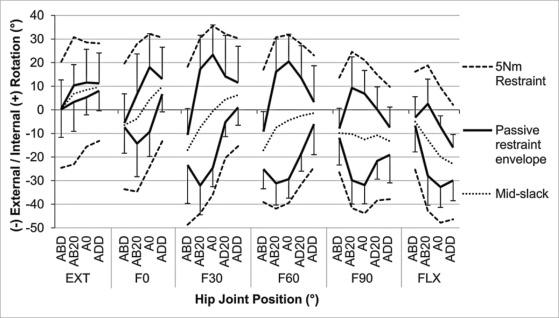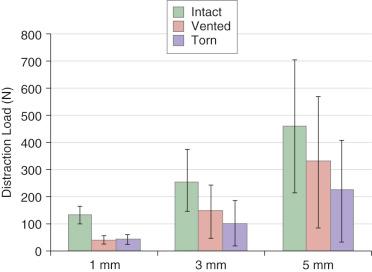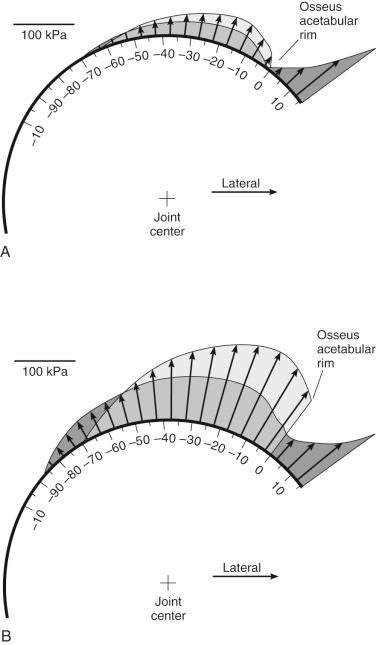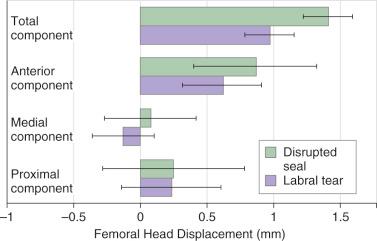Physical Address
304 North Cardinal St.
Dorchester Center, MA 02124
The physiologic range of motion (ROM) of the hip is affected by many morphologic and soft tissue factors that are not well understood. Clearly, systemic factors, such as age and joint degeneration, impair motion. However, ethnicity, sex, and culture are also important, as remodeling changes occur over time to accommodate activities of daily living (ADLs).
The acetabular labrum plays a vital role in the function and lubrication of the hip. Acting as a mechanical seal in contact with the femoral head, the labrum restricts the egress of synovial fluid from the joint under load. However, whether this normal physiologic mechanism is restored after labral resection and refixation is unknown, although clinical results of this procedure are superior to those of resection alone.
Bony deformities of the proximal femur and acetabular margin have a dramatic impact on ROM of the hip and are implicated in the occurrence of coxarthrosis secondary to impingement. Many dysmorphic conditions can cause loss of abduction and a marked reduction in internal rotation of the hip in flexion. These conditions include slipped capital femoral epiphysis (SCFE), reduced femoral and acetabular anteversion, increased acetabular coverage, and asphericity of the femoral head. In active individuals, this may lead to pathologic changes at the labral-chondral junction and articular degeneration; however, the connection between morphologic abnormalities and coxarthrosis remains controversial.
Instrumented prostheses and 3-dimensional (3D) computer models play an essential role in measuring hip-joint reaction forces, especially during gait and stair climbing. During normal activities, the peak value of the joint force averages 2.1 to 5.5 body weight (BW), and they may reach values in excess of 8 BW during accidental stumbling.
In normal hips, the distribution of contact pressure is almost even over the joint surface, whereas in the dysplastic hip joint, pressure is concentrated on the anterolateral edge of the acetabulum. Peak contact pressures for dysplastic and asymptomatic hips range from approximately 3 to 10 MPa.
The hip joint plays a significant role in the human osteoarticular system both in terms of locomotion and as a load-bearing joint for the torso by transmitting weight to different areas of the pelvis. Efforts to improve the diagnosis and treatment of pathologic and structural abnormalities of the hip are built on a basic understanding of hip biomechanics, including the anatomy of the joint, its normal range of motion (ROM), and the function of the hip musculature during gait.
Advances in this field have included the development of more effective methods of evaluating joint function and understanding pathologic conditions, the scientific investigation of alternative surgical approaches for hip reconstruction, and the development of methods for measuring joint forces and moments developed in vivo. In addition, the application of biomechanical principles has helped shed new light on dysmorphic conditions compromising normal hip motion, whether they stem from acquired abnormalities (e.g., posttraumatic deformities, Perthes disease, SCFE), developmental abnormalities (e.g., congenital dysplasia of the hip [CDH], developmental dysplasia of the hip [DDH]), or abnormalities of unknown origin (e.g., the cam deformity of the femoral head–neck junction and pincer deformities of the acetabular margin). Ongoing investigations of the biomechanics of the capsule, labrum, and femoroacetabular impingement (FAI) hold the promise of revealing the underlying mechanism of “idiopathic” coxarthrosis.
Any review of the biomechanics of the hip should address both the kinematics and the kinetics of normal hip function. Joint kinematics is the study of angular or translational motion of the hip in response to applied forces. Kinetics is the study of forces and moments acting on the joint, most commonly during stance, gait, or functional activities. Typically, these forces are created by the balance between gravity, acting to pull the body to the ground, and muscle contraction, which serves to keep the skeleton aloft. This balance relies on the transmission of load by intermediate structures such as tendons, ligaments, the hip capsule, and the articular tissues.
Hip biomechanics is studied using an array of measurement and computer modeling techniques. Typically, joint kinematics are measured using motion-capture technology and/or wearable sensors that record the acceleration, orientation, and/or position of skeletal elements. Joint forces were directly measured in a small group of patients using hip prostheses instrumented with force transducers; however, a more feasible approach based on analytic models combines data obtained from gait and force platform measurements, with predictions of the force of contraction and line of action of the muscles acting across the joint.
The hip joint is classified as an enarthrodial ball-and-socket joint that allows for polyaxial articulation between the body and the lower extremity. The femoral head comprises nearly two-thirds of a sphere, whereas the mating acetabulum forms a hemisphere of the same diameter. The cartilaginous surfaces of the femur and the acetabulum are not perfectly conforming in that the femoral head corresponds more to a conchoid than a sphere. This permits the hip joint to undergo movement in an assortment of motion axes that allow flexion/extension, abduction/adduction, and internal/external rotation. Despite a sturdy articular capsule and ligamentous stability, the hip joint allows a great deal of mobility of the femur with respect to the pelvis. Joint motion is greatest in the sagittal plane, with the femur flexing and extending around a transverse (left-right) axis. With the knee flexed, the ROM of the hip in the sagittal plane is approximately 120 degrees with active flexion (140 degrees passive). Further motion is limited by the joint capsule. When the knee is fully extended, hip flexion is limited to only 90 degrees because of hamstring tension. Typical values for maximum hip motion are 120 degrees for flexion, 20 degrees for extension, 45 degrees for abduction, 30 degrees for adduction, and 40 degrees for internal and external rotation.
The unconstrained polyaxial motion of the hip joint accommodates an extraordinary range of activities, from low-demand ADLs, such as walking and sitting, to more demanding motions, as in kneeling and squatting, and even to more specialized, high-demand sports activities, such as martial arts, ice hockey, and ballet dancing. Hip joint motion is basically expressed as 3 components in the sagittal, frontal, and transverse plane, that is, flexion-extension, adduction-abduction, and internal-external rotation. The specific excursions of joint motion required by each activity may vary. A clear understanding of hip kinematics during different activities not only establishes our knowledge of the causes and progression of joint diseases, but also provides a baseline and target for treatment of the diseased hip.
Thanks to the development of motion analysis technologies, joint kinematics during various activities can be accurately measured in vivo. Common motion analysis methods include high-speed motion-capture systems, electromagnetic tracking systems, an inertial system, a model-based image-matching technique, and magnetic resonance imaging (MRI)–based assessment. Many investigators have reported measurements of hip kinematics during common ADLs, typically using a high-speed motion-capture system. For gait, jogging, and rising from a chair, the maximum hip flexion angles averaged 34.7 degrees, 36.7 degrees, and 81.3 degrees, respectively, while secondary hip motions in the coronal and transverse planes were small (< 15 degrees). For instance, during gait, average hip motions in the coronal and transverse planes were less than 1 degree of adduction and a little more than 2 degrees of internal rotation at the instants of maximum/minimum flexion.
Hip ROM varies with many factors—including age, gender, and ethnicity—such that “normal” values can be specified only within the context of a given population. In a comprehensive retrospective study (The First National Health and Nutrition Examination Survey ), ROM measurements from a sample of 1683 subjects were reported as a function of age (25–39, 40–59, and 60–74 years), sex, and ethnicity (white and African American). Upon comparison of age alone, hip flexion, extension, abduction, and internal/external rotation, all decreased with age, but not significantly. Additional measurements are shown in Table 1.1 .
| Motion | Combined Group | White Men | White Women | Black Men | Black Women |
|---|---|---|---|---|---|
| Hip Flexion | |||||
| Ages 25–39 y | 122 | 123 | 123 | 115 | 116 |
| Ages 60–74 y | 118 | 118 | 119 | 118 | 106 |
| Hip Extension | |||||
| Ages 25–39 y | 22 | 22 | 22 | 19 | 17 |
| Ages 60–74 y | 17 | 17 | 16 | 16 | 12 |
| Hip Abduction | |||||
| Ages 25–39 y | 44 | 46 | 44 | 41 | 38 |
| Ages 60–74 y | 39 | 39 | 40 | 38 | 37 |
| Hip Internal Rotation | |||||
| Ages 25–39 y | 33 | 34 | 33 | 32 | 27 |
| Ages 60–74 y | 30 | 31 | 29 | 27 | 25 |
| Hip External Rotation | |||||
| Ages 25–39 y | 34 | 33 | 36 | 32 | 32 |
| Ages 60–74 y | 29 | 27 | 32 | 27 | 28 |
In many Middle Eastern and Asian countries, daily activities involving religious practice or personal hygiene are performed with the hips in extreme flexion. For instance, some devout Muslims kneel 20 to 30 times each day with the hip in deep flexion; many Indians often bathe in a squatting position; and Chinese, especially those living in villages, squat deeply to use the toilet. In a study of Chinese subjects, peak hip flexion of 121 degrees was measured during squatting compared to only 90 degrees in a group of Western subjects. Similar findings were reported for Chinese subjects versus white subjects in Hong Kong. Moreover, higher secondary motions were observed during these high-flexion activities when compared with data of common ADLs. For instance, in a study by Mulholland and Wyss, hip external rotation reached 36 degrees for full squat and 60 degrees while sitting cross-legged; hip abduction ranged from 10 degrees to 30 degrees for full squat and from 40 degrees to 45 degrees while sitting cross-legged. This increase can be correlated with differences in repeated habitual activities involving squatting and kneeling compared with Western cultures.
The greatest kinematic demands are placed on the hip joint during sports and recreational activities, especially in terms of abduction/adduction and internal/external rotation. For example, during the standard movements of ballet, hip flexion reaches an average of 133 degrees during a ballet split, and values of abduction and internal and external rotation reached 73 degrees (grand écart facial, left hip), 38 degrees (right grand écart lateral, right hip) and 28 degrees (left grand écart lateral, right hip), respectively. Supraphysiologic hip motions were also demonstrated by goalkeepers in ice hockey, especially in the transverse plane, with an internal rotation of 42 degrees during the butterfly maneuver and a peak external rotation of 28 degrees during recovery. Extreme placement of the hip within its motion arc also accompanied common sexual positions. Specifically, 47 degrees of external rotation was demonstrated by men when lying on the left-side position. Table 1.2 summarizes the peak value of hip angles in 3 anatomic planes during 25 different types of activities.
| Activity | Flexion | Extension | Abduction | Adduction | Internal Rotation | External Rotation |
|---|---|---|---|---|---|---|
| Ballet dancing | 133 | −42.8 | 73.1 | 0 | 37.9 | −42 |
| Single leg jump | N/A | N/A | 5 | −5 | 6 | −5.5 |
| Football | 64.45 | −14.72 | 37.65 | N/A | 16.92 | −13.11 |
| Golf swing | N/A | N/A | N/A | N/A | 34.8 | −29.7 |
| Hockey | 61.7 | −20 | 35.1 | −10.7 | 42.3 | −28.4 |
| Kneeling | 110.5 | 0 | 26.7 | −4 | 12.1 | −25.1 |
| Lacing shoes | 121 | 92 | 14 | −7 | 10 | −5 |
| Landing | 95 | −9.25 | 30.1 | −21 | 21.6 | −14 |
| Lie down | 130 | 85 | 25 | −5 | 11 | −21 |
| Lunge | 74.2 | −9.2 | N/A | −13.3 | N/A | −19.3 |
| Picking | 110 | 74 | 21 | 3 | 32 | −3 |
| Running | 89.9 | −37.67 | 15 | −16 | 11.17 | −18 |
| Sex | 108 | −10 | 35 | −17 | 17 | −47 |
| Shuttle run | 54.7 | N/A | 27.8 | N/A | 24.1 | N/A |
| Side-step cutting | 54.1 | N/A | 33.1 | −24 | 22 | −6.5 |
| Sitting cross-legged | 101.7 | −1.9 | 34.1 | −2.4 | 11.9 | −37.1 |
| Soccer | N/A | −9.3 | 30 | −14.8 | 22 | 6 |
| Squatting | 121.3 | −11.2 | 29.5 | −22.4 | 18.7 | −31.6 |
| Stair ascent | 67.07 | 3.55 | 4.9 | −10.59 | 5.59 | −9.27 |
| Stair descent | 39.96 | 1.6 | 5.4 | −9.4 | 6.05 | −20.2 |
| Stand-to-sit | 115 | 80 | 19 | −2 | 9 | −14 |
| Step down | N/A | N/A | N/A | −18.8 | 5.4 | N/A |
| Step up-and-over | 51.1 | −9.9 | N/A | −17.4 | N/A | −20.7 |
| Taekwondo | 51 | −10.8 | 45.1 | N/A | 34.7 | −18.3 |
| Walking | 57.5 | −19.6 | 9.18 | −21.6 | 14.9 | −12.4 |
Hip symptoms—such as pain and fear or apprehension of “giving way,” “instability,” “popping out,” and “dislocation” of the hip—are commonly seen in individuals who routinely participate in sporting activities that place the hip in extreme positions. Loading of the hip at the extremes of its ROM in activities such as golf, martial arts, figure skating, football, ballet, and hockey generates excessive strains within the soft tissues, primarily the labrum and capsule. Thus repetitive participation in these activities can lead to soft tissue microtrauma and labral compression. Moreover, participation can cause overload and irritation of the labral and capsular tissues, which is related to increased risk of physeal abnormalities, hip deformity at skeletal maturity, and degenerative changes later in life.
The kinematics of the hip joint can be understood from the basic anatomy of passive stabilizers of the hip, including the capsular ligaments, acetabular labrum, and ligamentum teres.
The hip capsule completely surrounds the hip joint and includes 4 discrete ligaments: the medial iliofemoral, lateral iliofemoral, ischiofemoral, and pubofemoral ligaments. The medial iliofemoral ligament originates slightly anterior to the junction between the acetabulum and the anteroinferior iliac spine and inserts anterior to the lesser trochanter. The lateral iliofemoral ligament originates slightly posterior to the medial iliofemoral ligament and inserts along the anterosuperior base of the femoral neck. Together, the medial and lateral iliofemoral ligaments are known as the Y ligament of Bigelow or the Bertini ligament. They are the strongest of the capsular ligaments. The ischiofemoral ligament originates where the ischium meets the acetabular circumference and inserts immediately posterior to the lateral iliofemoral ligament at the base of the femoral neck at the superior end of the intertrochanteric line. The pubofemoral ligament originates on the superior pubic ramus adjacent to the acetabular circumference and inserts to the same location as the medial iliofemoral ligament. It is the weakest of the capsular ligaments.
The ligaments act to prevent hypermobility of the hip. They provide a slack region in which the femur can rotate freely but pull taut, either individually or collaboratively, to restrict hypermobility. The primary region of joint laxity for internal/external rotation and abduction/adduction occurs in mid-flexion. In 60 degrees of flexion and neutral rotation, approximately 55 degrees of abduction/adduction is available without capsular constraint. Similarly, at 60 degrees of flexion and neutral abduction/adduction, the range of internal/external rotation is approximately 50 degrees. Thus, during normal activities performed in mid-flexion, the hip can move freely under muscle action without limitation from the ligaments ( Fig. 1.1 ). However, at full flexion/extension or full abduction/adduction, the slack region is minimal. The capsular ligaments thus allow a full ROM when the ball-in-socket morphology provides all the necessary stability to the joint but limit the available range of rotation in positions in which the hip is vulnerable to impingement, edge loading, or subluxation.

The different ligaments making up the hip capsule become taut in different hip positions. The primary restraints against excessive abduction and adduction are provided by the pubofemoral and lateral iliofemoral ligaments, respectively. The primary restraint against excessive external rotation comes from the lateral iliofemoral ligament, while internal rotation is constrained by the ischiofemoral ligament, except in full extension, where the medial iliofemoral ligament provides the dominant restraint for both internal and external rotation. It resists external rotation by pulling taut in a straight line. However, during internal rotation, the medial iliofemoral ligament provides restraint by wrapping around the inferior femoral neck. The medial iliofemoral ligament is the main restraint on hyperextension and, when it pulls taut, its fibers more or less pull in a straight line between its origin and insertion. Excessive flexion is resisted by the ischiofemoral ligament as its fibers wrap tightly around the femoral head. This configuration prevents the head from subluxing in positions of deep flexion: for example, rising from a chair. This may be the hip's natural protection against posterior edge loading—something that is commonly observed in total hip replacement. After total hip replacement, the diameter of the femoral head is much smaller, and native ischiofemoral anatomy no longer has a surface to wrap around to pull taut. Thus any protection that the ischiofemoral ligament may provide against edge loading may no longer exist.
The acetabular labrum, a fibrocartilaginous lip attached to the bony margin of the acetabulum, deepens the acetabular socket, substantially extending coverage of the femoral head. The labrum is characterized by a 3-layer structure, with the inner layer at the articular surface covered by a fine mesh of type II collagen fibers, below which one finds a lamellar collagen structure and finally an outer periphery composed of dense connective tissue with fibers oriented circumferentially. In an extensive histomorphologic study, Won and coworkers identified key features in the anterior labrum, which other studies reported as the predominant area for labral tears, including a tall triangular shape with apex heights of up to 7 mm and sublabral clefts, perpendicular to the articular surface, at the interface between the labrum and the acetabular rim.
The labrum is an avascular tissue with only limited blood supply in the peripheral third of the tissue from the adjacent capsule. Its mechanical properties are highly anisotropic, with preferential stiffness in the circumferential direction and strong dependence of its mechanical competence on sex, anatomic location, and the degenerative state of the hip. Labral tears were first cited as a potential source of hip pain by Altenberg more than 30 years ago. Labral tears may result from trauma, hypolaxity of the capsule, dysplasia, or impingement.
A link between labral pathology and joint degeneration has been proposed, but only recently has the biomechanical function of the labrum been well understood. In the normal hip joint, the labrum contributes little in the way of direct mechanical resistance to joint loading despite its position and prominence at the acetabular rim. However, the compliant and elastic labrum serves as a mechanical seal at the joint periphery, enhancing lubrication by blocking passage of synovial fluid in and out of the joint. This seal is readily demonstrated by the well-known suction effect observed during distraction or dislocation of the hip in surgery; it increases joint stability and distributes compressive loads in a uniform manner, thereby decreasing surrounding cartilage stress ( Figs. 1.2 and 1.3 ). In a series of computer simulations and in vitro experiments, the labrum has been shown to allow a layer of synovial fluid to be maintained between the femur and the acetabulum, thus preventing direct contact of the articulating surfaces during short-term loading. With this seal, loads are transferred across the joint predominantly by uniform pressurization of interstitial fluid in the cartilage layers, not by direct solid-on-solid contact stresses. In the absence of this seal, deformation of the solid cartilage matrix is substantially greater. However, in vitro experiments showed that both sealing mechanisms are highly dependent on the fit of the compliant labrum against the femoral head.


The labrum might enhance retention of a lubricating boundary layer even after fluid film depletion. Over long-term loading, the labrum contributes an important source of resistance to the flow of interstitial fluid that is expressed from the cartilage layers of the joint under load. Cartilage layer consolidation, in principle similar to wringing out a sponge, is up to 40% faster following labral excision. This, in turn, dramatically influences internal stresses within the cartilage, as the center of pressure is shifted toward the rim and subsurface shear strains are increased at the subchondral interface, possibly contributing to delamination.
Damage to the labrum through injury or pathology can compromise its sealing function, resulting in subtle but critical destabilization of the hip ( Fig. 1.4 ). This can lead to a shift in the center of rotation of the joint, thereby increasing rim loading and potentially hastening the onset of early osteoarthritis (OA). Despite early descriptions of the labrum as a continuous structure with direct connection to the cartilage around the circumference of the acetabulum, studies have shown that the anterior aspect makes minimal contact with cartilage compared with the posterior aspect. Consequently, labral tears occur predominantly anteriorly as the result of inferior mechanical properties leading to hip instability and “watershed” labral lesions, which ultimately can lead to degenerative joint disease.

Reattachment of the damaged labrum has been suggested to partially restore its original function. This procedure avoids compromising the biomechanical function of the labrum caused by surgical debridement, which may otherwise lead to degenerative changes. Although the long-term results of labral reattachment are still unknown, short-term follow-up is positive, with improved clinical results and less prevalent signs of joint degeneration. A comprehensive labral repair using the ligamentum teres capitis has been proposed as a further step toward restoration of normal joint function.
The zona orbicularis (ZO) is a band of ligament fibers that encircle the femoral neck at the head-neck junction. It is formed of fibers of the capsular ligaments that wrap tightly around the femoral neck like the bladed aperture of a camera lens. The ZO is only apparent in the neutral hip position or when the hip is extended. When the hip is flexed, the ZO aperture structure opens, the fibers release from the femoral neck, and the ZO structure is no longer apparent because flexing the hip causes the relative direction of the fibers to change. In neutral and in extension, the ZO acts as a locking ring to prevent distraction of the head from the socket. When the ZO engages around the femoral neck, it might also pressurize the synovial fluid in the peripheral compartment to flow into the central compartment via the cotyloid fossa. Therefore it may have an important role in supplying nutrients to the cartilage surfaces.
Become a Clinical Tree membership for Full access and enjoy Unlimited articles
If you are a member. Log in here